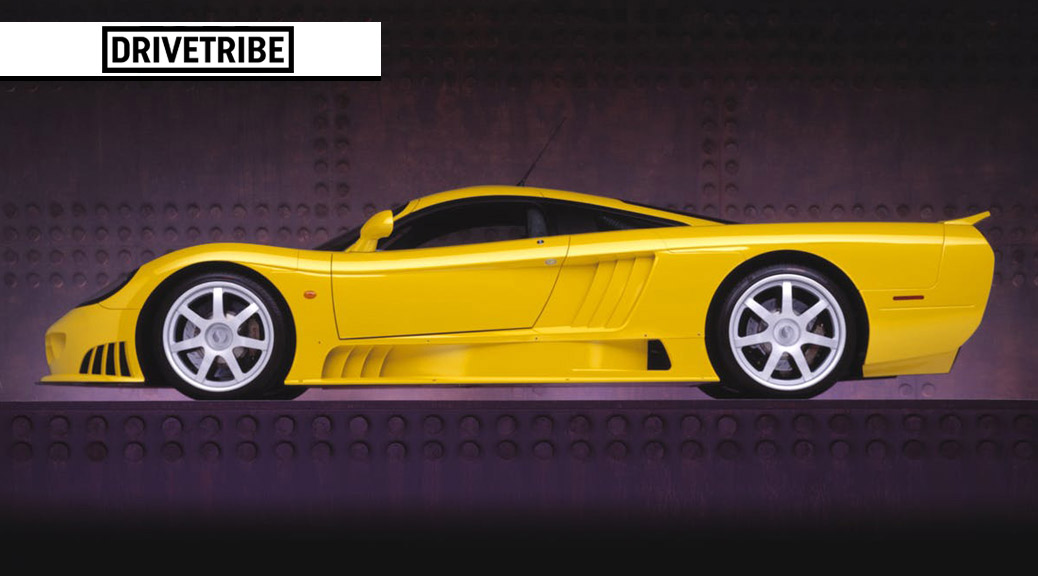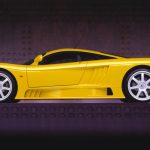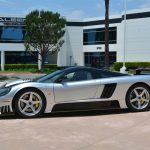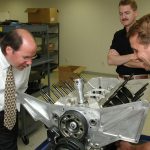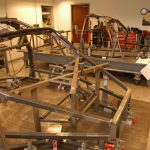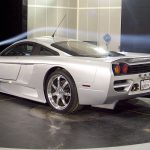Nearly 20 years on, the Saleen S7 is proving itself a classic
By: TOM WILSON on August, 2019
Original Article: DRIVETRIBE.COM
Nineteen years after its introduction and twelve years since it went out of series production, the Saleen S7 supercar is again attracting considerable attention. A new generation of enthusiasts is re-discovering the classically handsome, race-bred Saleen with still mind-bending performance. Plus, Saleen’s recent expansion into China has exposed the S7 to a giant new market that’s running up the S7 search engine hits on the Internet. But along with this new interest has come much speculation and mis-information about the iconic supercar and its origins.
Some of the mystery is due to the relatively thin official technical and build information available about the big Saleen. The early-aughts were hectic days at Saleen and there wasn’t the time or interest from the enthusiast magazines of the time to delve deeply into the details of the supercar’s origin. Saleen press materials had laid out the basics, the magazines had covered that and their driving impressions in new car reviews, the car sold itself on merit and there was plenty of international S7 racing to support, plus the whole business of building Saleen Mustangs. But aside from those early magazine reports, there’s been nothing of substance on the S7 story in many years; today that’s lead to a bit of unintended mystery surrounding the car, at least to those not familiar with the effort.

If there’s anything the Internet can’t support, it’s the mystery and all sorts of hokum that has surfaced regarding the S7. Eager enthusiasts can perhaps be forgiven for making assumptions about the car’s origins, but the amount of speculative, un-researched and downright wrong ‘journalism’ surrounding the S7 on the Internet is shameful and tilting toward the absurd.
The S7 truth is simple enough and follows the narrative laid out in the legitimate press during the car’s introduction. To briefly review, in 1999, Steve Saleen, realised the existing Mustang-based race car – the Saleen Mustang SR as campaigned in the U.S. and at Le Mans in 1997 – had reached the end of its development life. He ultimately decided to build his own, all-new race car, and by starting with a clean computer screen, opted for a mid-engine layout with a goal of winning the LMGT1 class at Le Mans.
While the previous Saleen Mustang SR racers had evolved from street cars into race cars, the S7 was from the beginning a dual-purpose machine, a race car simultaneously developed as a street car. Steve not only wanted a winner at the most demanding sportscar race in the world, but also a purebred sports/supercar for the street. During the car’s design, the racing and street versions were kept amazingly similar, which explains why the S7 has always been a no-excuses driver’s car, one which in street form easily preserves the directness and honesty of its racing roots. It also belies any misplaced concept that the S7 was some revision of an existing design; it’s simply too specialized for that; combining its thumping V8 and high downforce aero package are incompatible with any previous designs.

While Saleen as a company was well-versed in racing and speciality car manufacturing in 1999, like any car maker it needed to augment its engineering and fabrication capabilities when laying down their supercar’s chassis and suspension. After all, creating a Le Mans chassis from scratch requires specialized engineering and prototyping skills, especially when the latest, F1-level of aerodynamic knowledge is being sought. So, Saleen went looking for specialist contractors and found them, not unexpectedly, in the home of international road racing, the English Midlands. Besides its technical advantages, the Midlands also offered remoteness from the U.S. automotive scene and thus eased the security that such projects require.
While the prototype S7’s all-new, honeycomb-reinforced space frame chassis came together in England, back in Irvine, California Steve directed Saleen’s in-house race engineer and all-round secret weapon, Billy Tally, to develop an American-style cam-in-block V-8 for the new car. Leveraging extensive motorcycle, NASCAR and off-road racing experience into the S7’s namesake 7.0-litre V8, Saleen specified his own block casting, innovative clutch, starter, intake, dry-sump oiling, NASCAR-derived cylinder heads and front engine dress to package the powerplant in a mid-engine chassis. Saleen also determined all engine internals and tuning, including camming, electronic tuning and valvetrain oil spray system. Dyno development was done by Tally in Southern California and the engines built in-house at Saleen. Transaxles were RBT units on street cars and Xtrac on S7R race cars.
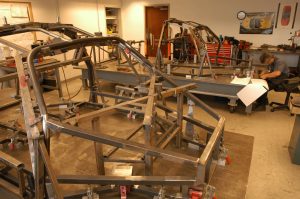
All S7s, both street and race, naturally-aspirated or turbocharged, have used this engine with only minor variations. The exception is the final Le Mans edition S7s. More the product of 2019 engineering, they retain the 427’s 7.0-litre displacement and bottom end, but have seen considerable changes in the cylinder heads, intake, turbos, charge cooling and a generational advancement in electronic engine management to arrive at 1,300bhp on gasoline and just shy of 1,500bhp when running E85 ethanol/gasoline fuel and 20+lbs of boost. The original engine was equally capable. In its first, naturally aspirated trim it was rated at 550bhp; adding twin turbochargers to it in the S7 Twin Turbo model bumped its rating to 750bhp via a mere 4.5lbs of boost. A pair of optional, non-street legal upgrades bumped the TT all the way to 1000bhp for track use at just 8lbs of boost.
Along with the chassis built by Ray Mallock (RML) in the English Midlands, and engine development at Saleen in Irvine, Calif., the S7’s body and interior were designed by Steve and Phil Frank, the latter having exercised his considerable talents at Saleen for five years by the time of the S7 project in 1999-2000. Aerodynamic work in England and the wind tunnel at the University of Glasgow in Scotland, plus rules requirements of the ACO organization running the Le Mans race were factors in the S7’s shape, a form that Phil and Steve worked especially closely together on.
When the S7 debuted in August 2000 at the Monterey Historic Races, it was both a complete surprise to the public and a prototype still some way from series production. Much work remained to arrive at a saleable street car, or even more immediately, a workable race car.
Before 2005 when the Twin Turbo street version of the S7 appeared, essentially every system, part and manufacturing process of the S7 was U.S. based, mainly in Saleen’s own Irvine facility or by a few remaining contractors. The chassis took form in Saleen’s in-house fabrication shop, the engines were built in the Saleen engine shop, the bodywork laid out in Saleen’s carbon shop and painted in the Saleen paint shop, the interior crafted in the Saleen upholstery shop and the whole car assembled on Saleen’s dedicated S7 assembly line.
List of S7 Contractors
No automaker designs or builds something as complex as a new car without the aid of skilled specialist contractors. Some of those individuals and companies that contributed to the S7 success are:
• Aria Group (USA)
• Brembo S.p.A. (Italy)
• Andy Coventry, Williams F1 aerodynamicist (UK)
• Frazero (UK)
• Lola Cars International (CTS carbon fiber division) (UK)
• Ray Mallock Limited (UK)
• RBT Transmissions (USA)
• University of Scotland (UK)
• Xtrac Transmission Technology (UK)

As a race car, the S7R was, like the street car, a major success, winning over 100 professional events and proving one of the outstanding customer racecars of the modern era. Its combination of blistering speed, durability, easy serviceability and support from the Saleen factory ensured its steady employment among teams contesting IMSA, ALMS, FIA and Le Mans series events in the United States and abroad. And yes, it did – finally – win its GT class at Le Mans in 2010.
Such racing success significantly differentiates the S7 from its supercar classmates, nearly all of which are street-centric. As a rule, such supercars are certainly capable, but tuned to protect the more exuberantly enthusiastic drivers rather then reward the skilled. By comparison, the track-bred S7 is honed right to the edge and delivers a far less-filtered, purer driving experience that’s loud and high effort because that’s the way hardcore driver cars are. It’s not for everyone, but it gives those in the know a uniquely authentic race car experience and doesn’t hurt the car’s honestly earned cache one bit.
Critics have called the S7 out precisely for its elemental approach, saying the project was too large for Saleen to complete, or hinting it was somehow not really a Saleen product and was opportunistically brought in from elsewhere. Nothing could be further from the truth. There’s more of Steve Saleen in the S7 than any other car he’s built.

He conceived the very idea of the car, directed every aspect of its engineering and design, was its chief development driver and has been hands-on for every step of the S7 story. In return, the S7 inarguably cemented Saleen’s reputation as a manufacturer, so much so that in 2002, the Ford Motor Company contracted Saleen for the engineering, painting and manufacturing of its own supercar, the first generation Ford GT, in a Saleen assembly plant.
Today, although long out of production save the final handful of Le Mans edition cars, the S7 continues as the Saleen flagship, still drawing attention both in the West and in China where its star power has visibly anchored the immense Saleen initiative there. It’s a natural job for the S7 as its direct approach to driving, prodigious performance and timeless styling have made it a modern classic among supercars.
Tom Wilson
Tom Wilson’s three decades of full-time auto journalism have included a 16-year association with Road & Track magazine, features and new car reviews for MSN Autos and editing Super Ford magazine, along with several technical books and aviation writing. Tom has driven nearly every Saleen model ever built and has chronicled the S7 story since the start. He is currently working on the definitive S7 book set for publication by next year.
[Source: DriveTribe]

